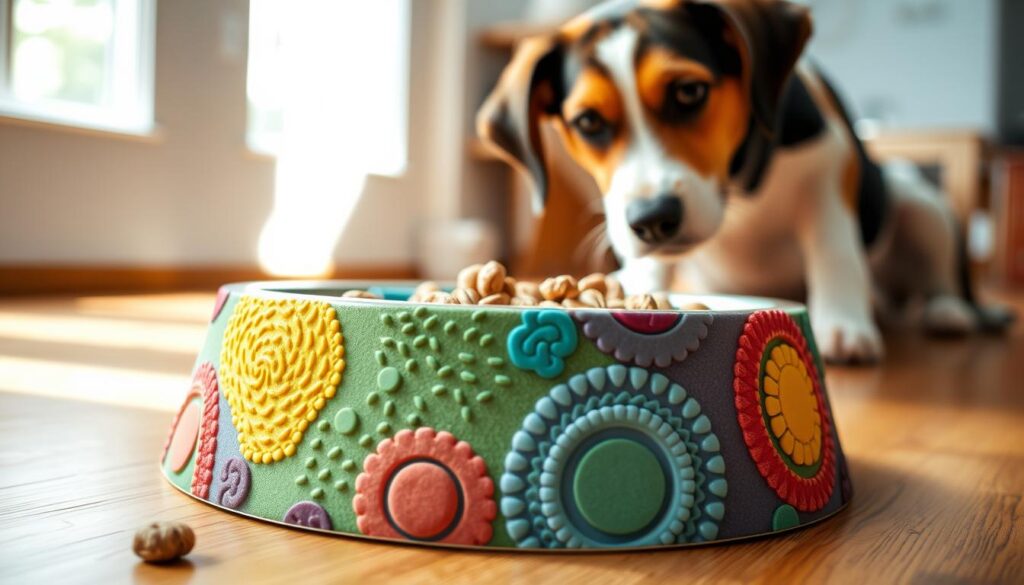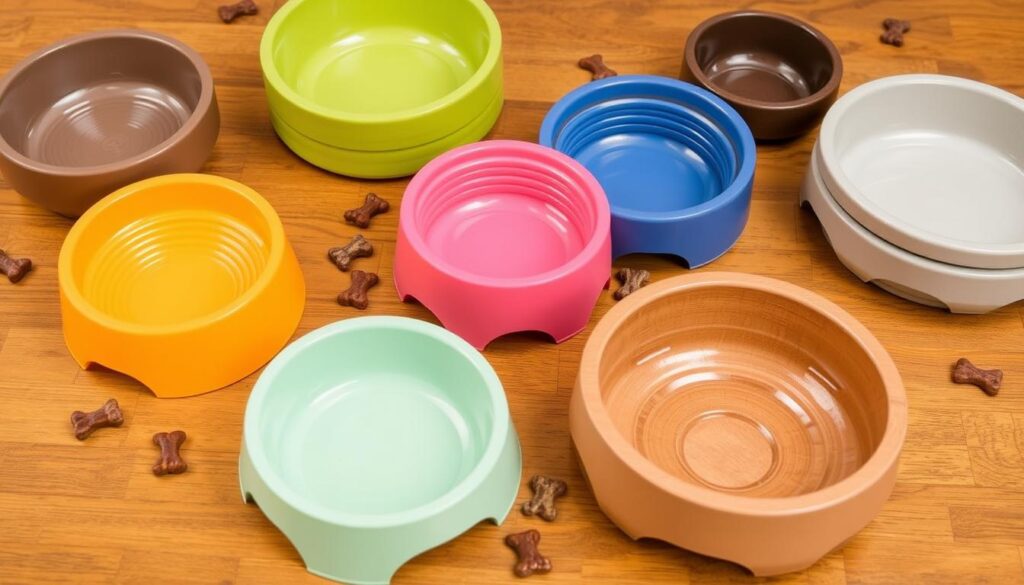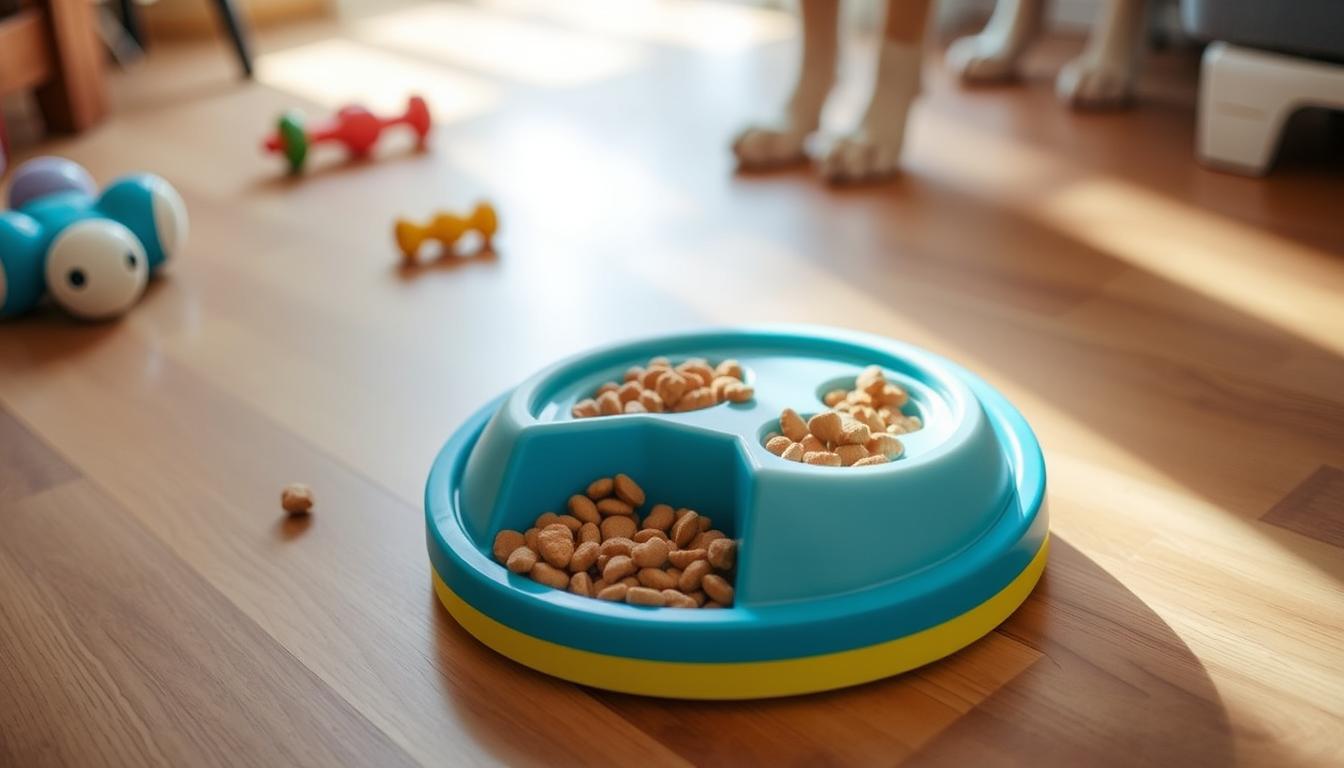As a pet owner, making sure your dog is healthy is key. A simple way to help is by using a slow feeder dog bowl. These bowls slow down your dog’s eating, which is good for their health.
Key Takeaways
- Slow feeder dog bowls prevent fast eating, which can cause health issues.
- These bowls help dogs eat slower, improving digestion and reducing stomach problems.
- They also help with weight control by stopping overeating and ensuring the right food amounts.
- Slow feeders can solve issues like eating too fast or begging for more food.
- Choosing the right size and design for your dog is important for the best results.
Understanding What a Slow Feeder Dog Bowl Is
A slow feeder dog bowl is a special dish for your pet. It helps them eat slower. These bowls have mazes or ridges that make it hard for dogs to gobble their food fast.
Basic Components and Design Features
Slow feeder dog bowls have a few key parts:
- Raised platforms or dividers that create a maze-like pattern
- Textured surfaces or elevated edges to slow down food intake
- Durable, non-slip materials to keep the bowl stable during use
- Ergonomic shapes that fit comfortably in your dog’s feeding area
How These Bowls Differ from Regular Feeding Dishes
Slow feeders are different from regular bowls. They make eating slower and more controlled. Unlike flat-bottomed bowls, slow feeders have mazes that slow down eating. This helps prevent digestive problems.
| Feature | Regular Dog Bowl | Slow Feeder Dog Bowl |
|---|---|---|
| Design | Flat-bottomed, simple | Complex maze-like patterns, raised platforms |
| Eating Speed | Allows for rapid consumption | Encourages a slower, more controlled pace |
| Digestive Benefits | May contribute to overeating and digestive problems | Helps prevent common issues like bloat and vomiting |
Understanding slow feeder dog bowls helps you choose the best for your dog.
The Health Benefits of Using a Slow Feeder Dog Bowl
Adding a slow feeder dog bowl to your pet’s meals can greatly improve their health. These bowls make eating slower and more mindful. This can positively affect your dog’s overall health.
One key benefit is better digestion. Slow feeder bowls prevent dogs from eating too fast. This reduces the risk of stomach problems like bloating and vomiting. It helps keep your dog’s digestive system healthy.
Slow feeder dog bowls also help with portion control. Dogs often eat too much if they can. But slow feeders help them eat at a slower pace. This makes them feel full without overeating.
| Health Benefit | Description |
|---|---|
| Improved Digestion | Slow feeder bowls prevent rapid gulping, reducing gastrointestinal issues like bloating and vomiting. |
| Better Portion Control | Slow feeders encourage a more moderate pace of eating, helping dogs avoid overeating and weight gain. |
| Reduced Risk of Bloat | The slower eating process reduces the likelihood of a dangerous condition called gastric dilatation-volvulus (GDV) or bloat. |
Moreover, slow feeder bowls can lower the risk of bloat. Bloat is a serious condition where a dog’s stomach fills with gas and twists. Slow feeders help prevent this by slowing down eating.
Using a slow feeder dog bowl can greatly benefit your pet’s health. It supports digestion, helps with portion control, and lowers the risk of bloat. Mindful feeding can make your dog’s life happier and healthier.
Signs Your Dog Needs a Slow Feeder Bowl
If your dog eats their meals too fast, it’s time for a slow eating dog bowl. These bowls help your dog eat more slowly. This can be good for their health and happiness.
Common Eating Problems in Dogs
Dogs can face many eating issues, such as:
- Eating food too quickly
- Vomiting soon after eating
- Feeling bloated or having stomach pain
- Choking or gagging on their food
Behavioral Indicators to Watch For
Your dog’s behavior can also show they need a doggie water bowl that slows down eating. Look for signs like:
- Frantically licking or pawing at their dog water bowls during and after meals
- Pacing or circling around their food dish
- Feeling anxious or agitated at mealtimes
Health Symptoms That Suggest Fast Eating
Eating food too quickly can lead to serious health issues, such as:
- Canine bloat, a potentially life-threatening condition
- Gastrointestinal distress, including diarrhea and constipation
- Increased risk of obesity and diabetes
Switching to a slow feeder dog bowl can help prevent these problems. It supports your dog’s overall health and happiness.

Types of Slow Feeder Dog Bowls Available in the Market
Looking for the right bowl of dog food to slow down your dog’s eating? There are many dog bowls to slow eating out there. They come in different materials, designs, and sizes to meet the needs of all dogs.
One common type has a maze inside the bowl. This maze makes your dog work to get their food. It slows down their eating and keeps them mentally active during meals.
Another design has raised platforms or ridges. These create small spaces for your dog to eat from. It’s great for brachycephalic breeds who eat fast because of their face shape.
For bigger dogs, there are dog bowls to slow eating with a bigger surface and deeper walls. These bowls help prevent rapid eating. They also have non-slip bases to keep them steady.
Slow feeder bowls are made from stainless steel, ceramic, and silicone. Each material has its own benefits, like being durable or easy to clean. This lets you pick the best one for your dog.

Choosing the right bowl of dog food to slow eating is key. Think about your dog’s size, breed, and diet needs. Exploring the many slow feeder options can help you find the best one for your dog’s health and happiness.
How to Choose the Right Size and Design for Your Dog
Finding the perfect slow feeder dog bowl can greatly improve your dog’s mealtime. It’s important to think about your dog’s needs when picking the right size and design.
Small vs. Large Dog Considerations
The size of your dog is key in picking the right slow feeder bowl. Small breeds need a compact, shallow bowl to eat slowly. Large dogs need a deeper, bigger bowl to fit their size and eating style.
Material Selection Guidelines
The material of the slow feeder bowl is also crucial. Choose durable, non-slip materials like stainless steel or heavy-duty plastic. They’re easy to clean and won’t break easily. Stay away from light or flimsy materials that can tip over.
When picking a slow dog feeder, consider these factors:
- Size of your dog (small, medium, or large)
- Depth and design of the bowl to suit your dog’s eating habits
- Durability and non-slip properties of the material
- Ease of cleaning and maintenance
Choosing the right slow feeder dog bowl can help your dog eat healthier and digest better. It makes mealtime more enjoyable for both you and your dog.
| Dog Size | Recommended Bowl Size | Suitable Design Features |
|---|---|---|
| Small Dogs (under 20 lbs) | 5-8 inches in diameter | Shallow depth, multiple maze-like ridges |
| Medium Dogs (20-50 lbs) | 8-12 inches in diameter | Moderate depth, complex maze patterns |
| Large Dogs (over 50 lbs) | 12-16 inches in diameter | Deeper bowl, large maze or spiral design |
Introducing Your Pet to Their New Slow Feeder Dog Bowl
Introducing your dog to a new slow feeder bowl can be easy with the right steps. These bowls help your dog eat more mindfully, which is good for them. But, it’s key to introduce it slowly to make sure your dog enjoys it.
Begin by putting the new bowl next to their usual dish for a few days. Let your dog explore and get used to it. This way, they’ll link the bowl to good times, like meals. It helps them feel at ease and avoids any stress.
- Start by giving your dog their usual food in the new bowl, a little at a time.
- When your dog checks out the bowl, give them praise and treats. This makes them think it’s a good thing.
- Remember, some dogs might need more time to get used to eating this way.
Keep an eye on how your dog eats and acts while getting used to the new bowl. If they seem upset or don’t want to use it, slow down. We want the transition to be easy for your furry friend.
Using a slow feeder bowl can really help your dog. It can improve digestion, reduce bloating, and make eating slower. With patience and encouragement, your dog will start to love their meals more and get healthier.
Maintenance and Cleaning Tips for Long-lasting Use
Keeping your dog’s slow feeder bowl clean is key to its long life. It ensures a safe and healthy mealtime for your pet. Regular cleaning, both daily and deep, helps your dog water bowls or doggie water bowls last longer. It keeps your dog’s meals clean and enjoyable.
Daily Cleaning Practices
After each meal, rinse your slow feed dog bowl with warm water. Make sure to remove all food residue. Use a soft-bristled brush or sponge to clean the bowl, especially the grooves and ridges.
After rinsing, dry the bowl well before putting it back. A damp bowl can grow bacteria, which is bad for your pet’s health.
Deep Cleaning Methods
Every now and then, do a deep clean of your dog’s slow feeder bowl. The cleaning method depends on the bowl’s material:
- Stainless steel bowls: Soak in warm water and mild dish soap, then scrub with a soft sponge or cloth.
- Plastic bowls: Use a baking soda and water mix to scrub and remove stains and odors.
- Ceramic bowls: Soak in a vinegar and water mix for 15-20 minutes, then scrub and rinse well.
By following these cleaning tips, your dog’s slow feed dog bowl will stay in great shape. It will provide a safe and comfortable mealtime for your pet for many years.
Common Mistakes to Avoid When Using Slow Feeders
Using a slow eating dog bowl can be tricky. One big mistake is not slowly introducing it to your pet. Switching too fast can confuse and upset your dog. Start by introducing the slow feeder a little at a time, over several days.
Choosing the wrong size bowl is another common mistake. A bowl that’s too small can make eating hard for your dog. On the other hand, a bowl that’s too big might not slow down eating as much. Make sure to pick a size that fits your dog’s needs.
Not cleaning the bowl often is another error. Food and bacteria can build up in the design, causing health issues. Clean the bowl regularly to keep it safe and effective for your dog.

